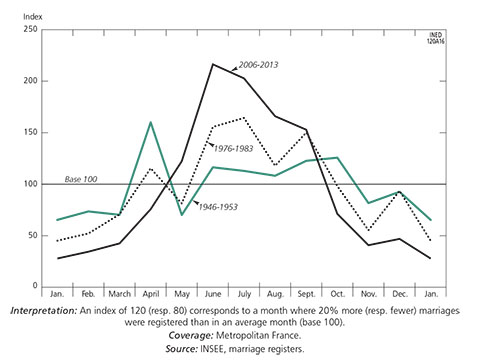Marriage seasonality (1946-2013)
For the 70th anniversary of its founding, the journal Population has been republishing articles from its 1946 issues, each commented upon by present-day researchers.
Here Arnaud Régnier-Loilier and Wilfried Rault relate Jean Bourgeois’ findings in his 1946 article on the seasonality of marriages to the current situation.
Marked seasonality through today
In 1946, Jean Bourgeois found strong seasonal variation in marrying throughout French society. Seventy years later, that variation is also quite marked but the periods in which marriage rates are highest have gradually changed.
Trends in monthly distribution of marriages, 1946-2013 (monthly index base 100)

While the religious calendar and farming activities in rural France used to dictate marriage seasonality, today’s peaks in marrying seem correlated with favorable weather conditions (from 2006 to 2013, most weddings were held between June and September).
The changed meaning of marriage
In the course of 70 years, the number of marriages per year in France has fallen sharply (from an average of 360,000 from 1946-1953 to 248,000 for the 2006-2013 period).
The weakening of the institution of religion has changed the marriage calendar, and only a small proportion of couples have a church wedding now (fewer than 3 in 10 in 2012). Choice of spouse, wedding date and ceremony format are now much more a matter of individual choice rather than external norms.
In studying marriage seasonality, we discover fundamental aspects of the society as a whole and how it is organized.
Source: Wilfried Rault and Arnaud Régnier-Loilier, 2016, Seasonality of marriages, past and present, Ined, Population, 71 (4).
Contact: Wilfried Rault and Arnaud Régnier-Loilier
Online: April 2017
